I. L. Zalivsky. Lilies Brief botanical characteristics of lilies. General information
Lily is a perennial bulbous plant of the lily family. General features of the genus - the presence of bulbs, consisting of separate, adjacent to each other scales; six-petalled flowers with 6 stamens and three-cephalic ovary; elongated leaves with parallel venation.
Plant structure:
The flower consists of 6 separate falling petals (tepals), 6 stamens with long staminate threads and large elongated anthers, a three-celiac ovary and a pistil with a three-part stigma. Parts of a flower, depending on the variety and type, vary in shape and color. The size, color and shape of flowers are diverse and are the main varietal characteristics. The smallest flowers of wild-growing lilies have a callus (diameter 2-3 cm), low (dwarf) 4-5 cm; the largest ones are in the golden, beautiful and their hybrids (the flower diameter reaches 25-30 cm). To determine the size of a flower, its diameter and height are taken into account. The varietal characteristics also include the length and width of the petals. Of the 6 petals, 3 are located on the inner circle (they are, as a rule, wider, 3 outer petals are somewhat narrower, sometimes the same in size). The size of the flower and its parts also depend on external conditions (unfavorable causes its decrease) and on the location of the position on the peduncle (larger flowers are located at the base of the inflorescence). The main forms of lily flowers: tubular, cup-shaped (cup-shaped), funnel-shaped, star-shaped (star-shaped), talmiform, bell-shaped. Each form is peculiar to a particular species. But due to interspecific and intervarietal hybridization, many forms appeared that have an intermediate character, so you have to resort to additional characteristics: star-shaped flat, star-shaped with bent tips of petals, wide-shaped, etc. Coloring of flowers is very diverse: so far there are no blue and blue lilies . Particularly appreciated varieties with bright net color, glossy surface of the petals. White coloring is peculiar mainly to tubular and long-flowered lilies, but hybridization made it possible to obtain yellow, pink, purple and apricot tubular lilies. At the same time, with the help of selection, white-flowered varieties were bred in the group of Asian lilies. If a few years ago, Asian, red and yellow colors prevailed in Asian lilies, then modern hybrids have pink, white, lilac, apricot and many transitional colors. Coloring of anthers, pollen, filaments, pistil and stigma refers to the varietal characteristics. The color of the open anther determines the color of pollen, which does not coincide with the color of the closed anther. The varietal characteristics also include the presence and nature of specks (specks) on the petals. They vary in color, size, shape, number and density of placement. Currently, breeders are working on the breeding of Asian Hybrids that are free from specks and have already achieved positive results. Do not have specks of Connecticut King, Connecticut Meid, Dressy and other new hybrids. The flowers of many lilies have a fragrance: pleasant and delicate in Oriental and long-flowered species and hybrids, sharp - in most tubular lilies. Most Asian lilies lack a scent, although among them there are fragrant (low, drooping). The use of these species in breeding makes it possible to obtain fragrant varieties. Inflorescence often consists of 5-35, and sometimes more flowers. Rarely peduncle has 1-2 flowers. Depending on the structure, the following botanical types of inflorescence are distinguished: racemoid, paniculate (paniculate), umbrella-shaped (umbellate), flaky. Lilies are monocot plants. The leaves are usually linear or lanceolate with a longitudinal (parallel) venation. Their width varies from 2-3 to 5-6 cm, length - from 2 to 20 cm. The size of the leaves varies even within a single plant: usually in the upper part of the stem (sometimes in the lower one) the leaves are smaller. The leaf position on the stem is usually alternate - in the drooping lily, callus and others, and whorlid - in the wispy lily, Gunson and most West American species. Turbid arrangement is often combined with another: as a rule, the lower leaves are arranged in whorls, the upper - in a spiral. Leaf color: from light green to dark green and dark purple. Especially beautiful leaves with a glossy surface. Some species and varieties have leaves and stem pubescence. The stem of a lily can be of different heights - from 15–20 cm in some wild species and up to 2.0–2.5 m in oriental lilies and their hybrids. The surface of the stem is smooth, sometimes pubescent, the color is green or brown. In a number of species and varieties, on the stem in the leaf axils, by the end of flowering, small aerial buds (bulbs) are formed. Such lilies are called bulbous, these include tiger, bulbous, lanceolate and many varieties derived from them (Redstart, Svetlana, Aelita, Inchantation). Pochkolukovichki, falling on the ground, germinate, thus ensuring the reproduction of plants. A lily bulb is a shortened stem with fleshy scales (modified leaves) that are more or less densely placed on it. The bulb is a repository of nutrient reserves, with which the plant starts to grow in the spring. It provides wintering perennial in adverse conditions. The color of the bulbs is determined by species and varietal affiliation. In most Asiatic lilies, it is white, in tubular ones it is purple, in Caucasian species it is yellow. The size, shape and nature of the scales also vary with species. Thus, in oat flake lily, in size and shape they resemble oat grain, they are unstable on the bottom, break off easily and, once in the soil, give rise to new plants. Very large scales in Caucasian lilies and Henry - up to 10 cm in diameter. The growth of new scales comes from the center of the bulb. Periodically (usually in the second half of summer), external scales die off. Each scale and even its part, separated from the bulb, have the ability to form small onions, which, when planted in the soil, give new plants. The roots of most species of lilies are divided into two types: the main (podlukovichnye), growing from the base of the bottom, and the stem (seasonal, hyperlabic), formed on the short underground part of the stem. The main roots serve to nourish and fix plants in the soil, and the super-roots, mainly to feed and absorb moisture from the surface soil layers. These roots, appearing in the spring along with the growing stem, in the autumn die with it, whereas the main ones can live up to one and a half seasons. Seeds of lilies are formed in the fruit-boxes, developed from a three-cephalic ovary and, accordingly, have 3 rigid partitions, on both sides of which are attached flat, membranous, oval-shaped seeds. The comma-shaped embryo is easily visible through the seed sheath and a thin layer of endosperm, thus allowing the rejection of “empty” seeds. Most lilies belong to the cross-pollinated plants, therefore seed-setting, as a rule, occurs when ingested or artificially applied to the stigma of pollen from other plants. Many varieties, especially those from the Asian, Long-flowered and Eastern Hybrids, do not accept their own pollen. Such plants are called self-sterile. Easy to form the seeds of wild lilies, giving a homogeneous offspring. Well propagated by the seeds of the lily regal, low, monochrome, drooping, Wilmott, as well as varieties - the lines (strains) of the Tubular Hybrids. When sowing seeds of tubular lilies from free pollination, the offspring is heterogeneous and loses the quality of the original variety. In this case, the plants are only seedlings of this variety.
Lilia got its name from the ancient Gallian word "li-li", which literally translates as "white-white." Its first images are found in Cretan vases and frescoes from 1750 BC, and then among the ancient Assyrians, Egyptians, Greeks and Romans.
White lily since ancient times - a symbol of innocence and purity. Egyptians decorated with lilies the bodies of dead young girls. In ancient Rome, white lilies were considered colors of grace, wealth and luxury, as well as hope.
Lily is a symbol of France: three crossed lilies are depicted on its coat of arms, which means mercy, justice and compassion. In Christianity, the lily is a symbol of innocence and chastity. The Most Holy Virgin in many Catholic countries was depicted surrounded by garlands of lilies.
The ancient Greeks attributed to lilies divine origin. According to legend, white lilies emerged from drops of Hera's milk - the wife of the lord of the gods Zeus. Theban Queen Alkmena secretly gave birth to the boy Heracles from Zeus, but, fearing being punished by the Hero, hid the newborn in the bushes. However, Hera accidentally discovered the baby and decided to breastfeed him. But little Hercules felt the enemy in Hera and rudely pushed the goddess away. Milk splashed onto the sky, causing the Milky Way to form, and those few drops that fell to the ground sprouted and turned into lilies.
For several millennia BC, lilies were cultivated not only as ornamental, but also as medicinal, cosmetic, and food plants. There is information that in the 4th century BC, the magnificent garden of the Athenian beauty Phryne was buried in white lilies. The capital of Ancient Persia, Susa was called the town of lilies, and its coat of arms depicted several flowers of this magnificent plant.
Young Roman women in honor of the flower competed in the race at the Flora festival (Florals), where the winner was certainly decorated with a wreath of white lilies, and each girl thought herself looking for a similar wreath.
Lily classification
It all started many centuries ago with one "divine" lily. She was glorified, worshiped, she became the main symbol on the royal coats of arms ... And so it continued until the 19th century, until other types of lilies from distant countries came to Europe: Central Asia, China, Japan and America. At this point, breeders took up the case. And now, two centuries later, we have such a variety of lilies of various varieties, shapes and colors, which gardeners could not even dream of. But any diversity raises the question: how to classify the newly displayed varieties, so as not to completely get confused. And in 1962 the first was published International classification of lilieswhich with small changes has been preserved to this day. All cultivated varieties of lilies were divided into 9 classes, depending on the origin of their wild ancestors and general requirements for growing conditions:
Group 1 - Lilies Asian hybrids (Lilium Asiatic Hybrids)
Group 2 - Lilies Cornrips / Lilium Martagon (Lilium Martagon Hybrids)
Group 3 - Lilies Candidum hybrids (Lilium Candidum Hybrids)
Group 4 - American Lilies hybrids (Lilium American Hybrids)
Group 5 - Long-flowered Lilies hybrids (Lilium Longiflorum Hybrids)
Group 6 - Lilies Tubular hybrids (Lilium Trumpet Hybrids)
Group 7 - Lilies Oriental Hybrids (Lilium Oriental Hybrids)
Group 8 - New hybrid lilies: LA-librids, LO-hybrids, OT-hybrids (Lilium LA-Hybrids, Lilium LO-Hybrids, Lilium OT-Hybrids), etc.
Group 9 - Species lilies (Lilium species)
And although many signs, such as the height of lilies, the timing of lily blooming, the number of lily buds and flowers on one stem, can vary greatly depending on their growing conditions, the basic requirements for growing lilies of one group or another remain similar. You see, it is of paramount importance if you decide to replenish your collection with new varieties of lilies.
Well, now let's go directly to the description of the modern classification of lilies.
photo: Lily Fata Morgana
Group 1 - Lilies Asian Hybrids (Lilium Asiatic Hybrids)
Planting term lilies:
The term of flowering lilies: June-early August
Lily height: 0.4-1.2 m
Lily flower size: 10-14 cm
Lily flower shape:
20-30 cm
10-15 cm
Short description
Lilia Asiatic Hybrids (Lilium Asiatic Hybrids) - by far the most unpretentious lilies, which have proved their trouble-free cultivation even in regions with very cold winter. Asian lilies are ideal for beginner florist. Odorless, which is very important for people suffering from allergies. Resistant to diseases and pests. Easily multiply. In addition, Asian Lilies are very beautiful, have a juicy, bright color of various shades, as well as thick durable peduncles with numerous large flowers.
The group of lilies Asian hybrids got its name due to the fact that the basis of its hybridization are East Asian species of lilies, such as: David's lily (Lilium davidii), dwarf lily (Lilium pumilum), Lily Maximovich (Lilium maximowiczii), monochrome lily (Lilium concolor), drooping lily (Lilium cernuum), tiger lily (Lilium tigrinum), etc.
The height of Asiatic lilies varies widely: from 40 cm to 1.2 m. Flowers are 10-14 cm in size, collected in large inflorescences, reaching 15 or more flowers. Blooming time from late June to August. Asian lilies are intended both for decoration of a garden, and for cutting. Cut flower stalks of lilies are at home in a vase for 10-12 days.
The most popular varieties of Asian lilies:
Lilium Alaska / Lilium Alaska
Lilia Annemarie Dream / Lilium Annemarie "s Dream
Lilium Apeldoorn / Lilium Apeldoorn
Lilium Brunello / Lilium Brunello
Lily Vivaldi / Lilium Vivaldi
Lilia Gran Paradiso / Lilium Gran Paradiso
Lilium Double Sensation
Lily Dreamland / Lilium Dreamland
Lilium Yellow Submarine / Lilium Yellow Submarine
Lilium Yeti / Lilium Yeti
Lilium Cocktail Twins
Lily Compass / Lilium Compass
Lilia Connecticut King / Lilium Connecticut King
Lilium Cordelia / Lilium Cordelia
Lilia Lemon Stardust
Lily London / Lilium London
Lilium Loreto / Lilium Loreto
Lilia Mona / Lilium Mona
Lilia Monta Rosa / Lilium Monta Rosa
Lilium Montreux / Lilium Montreux
Lilia Nettis Pride / Lilium Netty "s Pride
Lilia Nove Cento / Lilium Nove Cento
Lily Pollyanna / Lilium Pollyanna
Lilia Rozellas Dream / Lilium Rosella "s Dream
Lilia Roma
Lilia Sunray / Lilium Sunray
Lilium Sancerre / Lilium Sancerre
Lilium Cecil
Lilium Spring Pink
Lilia Strawberry and Cream / Lilium Strawberry and Cream
Lilium Toscana / Lilium Toscana
Lilia Fata Morgana / Lilium Fata Morgana
Lilia Foreva Susan / Lilium Forever Susan
Lilium Hilde / Lilium Hilde
Lilium Elite / Lilium Elite
Lilium Elodie / Lilium Elodie
Lilium Enchantment
Growing Asiatic Lilies: see general
Buy Asian lilies by mail
![]()
on the photo: Lily Orange Tiger
Group 2 - Lilies Married / Lilium Martagon (Lilium Martagon Hybrids)
Planting term lilies: end of April - May or end of September - October
The term of flowering lilies: June July
Lily height: 1.2-1.8 m
Lily flower size: 5-8 cm
Lily flower shape: drooping, with broad petals
Lily planting distance: 20-30 cm
Planting depth of lily bulbs: 12-17 cm
Short description
Lilies Black-headed or lilies chappy or Lily martagon (Lilium martagon) - a group that has not received, unfortunately, wide distribution, although the marvelous lilies look very unusual: tall, up to 1.5 m, with widely spread peduncles, on which flowers of the talmiform form hang, 5-8 cm in diameter. In addition, it is perhaps the most marzo-resistant group of lilies, because their original form - Martagon lily - is found even in the harsh Siberian climate.
The color of dried lily flowers is the most diverse: white, yellow, orange, cherry, purple, ... And often with specks. Bloom in June and July. Used lily marstrenced mainly in group plantings and complex mixborders. And also among the low ornamental shrubs.
The most popular varieties of lily Kudrevatoy:
Lily Henry / Lilium Henryi
Lilia Lightlini / Lilium Leightlinii
Lilia Orange Tiger / Lilium Orange Tiger
Lilia Pink Tiger / Lilium Pink Tiger
Lilia Speciozum Rubrum / Lilium Speciosum Rubrum
Lilium Tigrinum Splenders
Lilia Fire King / Lilium Fire King
Lilia Flying Wing / Lilium Flying Wing
Lily Flora Pleno
Lilia Hiawatha / Lilium Hiawatha
Lily Citronella / Lilium Citronella
Growing lilies Kudrevaty: see general
Buy lilies Kudrevatye mail You can from May to August and from October to March in our online store "Garden of Dreams" (see the relevant section)

on the photo: White Lily (Madonna Lily)
Group 3 - Lilium Candidum Hybrids
Planting term lilies: end of April - May or end of September - October
The term of flowering lilies: June July
Lily height: 1.2-1.8 m
Lily flower size: 10-12 cm
Lily flower shape: tubular with folded petal tips
Lily planting distance: 20-30 cm
Planting depth of lily bulbs: 15-20 cm
Short description
Lilium Candidum or White Lily (Lilium Candidum Hybrids) - this is exactly the “royal” or “divine” lily that has been sung for centuries. And even now, after two centuries of breeding (together with the lilies of Chalcedony (Lilium chalcedonicum) and single-sided (Lilium monadelphium)), the varieties bred in the group of Liliya Kandidum hybrids are very few, and all of them have flowers of pure white, less often yellowish, coloring, tubular or broadly funnel-shaped with a delicate, pleasant aroma. At the same time, unlike other groups of lilies, Candide lily varieties do not have stem roots and bulb bulbs immediately turn into leaves, forming a wintering outlet for winter.
Lilies Kandidum prefer open sunny areas and slightly alkaline soil. In addition, for the Candida lily it is very desirable that the second half of the summer be hot and dry, then they better prepare for the winter period. Transplanting lilies of this group is best done immediately after flowering (early August).
The most popular varieties of lilies Candidum:
They are absent, only Lilium Candidum is found on sale (sometimes it is also referred to as Lily Madonna / Madonna LIly).
Cultivation of lilies Candidum: see general
Buy lilies Candidum by mail You can from May to August and from October to March in our online store "Garden of Dreams" (see the relevant section)
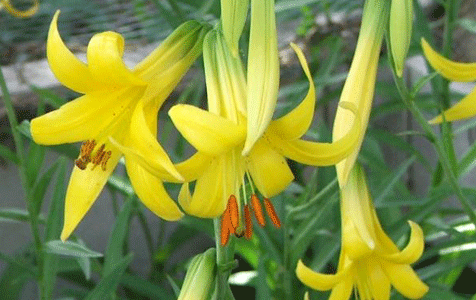
photo: Lilia Parry
Group 4 - Lilies American Hybrids (Lilium American Hybrids)
Planting term lilies: end of April - May or end of September - October
The term of flowering lilies: July
Lily height: 0.9-2 m
Lily flower size: 10-12 cm
Lily flower shape: bell-shaped or tubular
Lily planting distance: 20-30 cm
Planting depth of lily bulbs: 15-20 cm
Short description
Liliums American Hybrids (Lilium American Hybrids) combines the fact that they all originated from the crossing of lilies of North American species, primarily such as Parry lily (Lilium Parryi) and leopard lily (Lilium pardallinum), as well as Canadian lily (Lilium canadense), Humboldt lily (Lilium humboldtii), etc. It is the factor that the group includes a wide variety of hybrids between all the above listed lilies, makes it difficult to identify their common species and agrotechnical features, although among American lilies there are very interesting varieties. Unfortunately, in the "Old World" American lilies are not widely spread.
Most popular lily varieties American hybrids: absent
Growing lilies American hybrids: see general
Buy lilies American hybrids by mail You can from May to August and from October to March in our online store "Garden of Dreams" (see the relevant section)
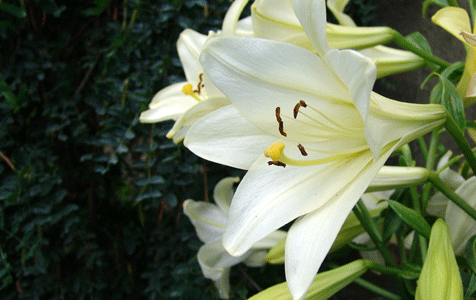
pictured: Lily Snow Queen
Group 5 - Lilium Longiflorum Hybrids (Lilium Longiflorum Hybrids)
Planting term lilies: end of April - May or end of September - October
The term of flowering lilies: July August
Lily height: 1-1.2 m
Lily flower size: 15-20 cm
Lily flower shape: bell-shaped
Lily planting distance: 20-30 cm
Planting depth of lily bulbs: 15-20 cm
Short description
Lilium Longiflorum or Lilium Longiflorum Hybrids - very beautiful lilies of gentle white color or white with light shades and delicate aroma. The flower of the lily longiflorum large, 15-20 cm in the form of a bell. The height of the stem is 100-115 cm.
Lilies Longiflorum perhaps the most capricious of all groups of lilies, because come from tropical lily species such as: Lilium longiflorum, Philippine lily (Lilium philippnense), Formolongi lily (Lilium formolongi), Formole lily (Lilium formozanum), etc. Therefore, lilies Longiflorum require no less care than lilies Oriental hybrids. They are used mainly for high-quality cutting.
The most popular varieties of lilies Longiflorum:
Lily Deliana / Lilium Deliana
Lilia Dolcetto / Lilium Dolcetto
Lilia Mayabi / Lilium Miyabi
Lilium Prince Promise / Lilium Prince Promise
Lily the Triumphant / Lilium Triumphator
Lilium White Heaven
Lilia Snow Queen / Lilium Snow Queen
Growing lilies Longiflorum: see general
Buy lilies Longiflorum by mail You can from May to August and from October to March in our online store "Garden of Dreams" (see the relevant section)

pictured: Lilia Regale
Group 6 - Lilies Tubular Hybrids (Lilium Trumpet Hybrids)
Planting term lilies: end of April - May or end of September - October
The term of flowering lilies: June-September
Lily height: 1.2-1.9 m
Lily flower size: 12-18 cm in length
Lily flower shape: tubular or funnel
Lily planting distance: 20-30 cm
Planting depth of lily bulbs: 15-20 cm
Short description
Lilies Tubular Hybrids (Lilium Trumpet Hybrids) - originate from hybrids of Asian lilies, which provides them with a fairly good simplicity and winter hardiness. Moreover, tubular lilies are practically not susceptible to viral and fungal diseases. Add to this high peduncles (1.5 m on average) and beautiful funnel-shaped flowers up to 18 cm long in a variety of colors plus very long flowering that can stretch up to three months and end in September and you will understand why the group of tubular lilies uses the same love and popularity among gardeners.
The most popular varieties of tubular lilies:
Lilia African Queen / Lilium African Queen
Lilium Pink Perfection
Lilium Regale / Lilium Regale
Lilia Royal Gold / Lilium Royal Gold
Growing Tubular Lilies: see general
Buy Tubular Lilies by mail You can from May to August and from October to March in our online store "Garden of Dreams" (see the relevant section)
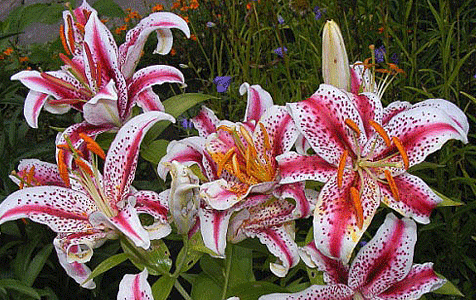
photo: Lilia Tiger Woods
Group 7 - Lilium Oriental Hybrids (Lilium Oriental Hybrids)
Planting term lilies: end of April - May or end of September - October
The term of flowering lilies: Aug. Sept
Lily height: 0.4-1.2 m
Lily flower size: 20-25 cm
Lily flower shape: wide open with corrugated petals
Lily planting distance: 20-30 cm
Planting depth of lily bulbs: 15-20 cm
Short description
Lilies Oriental Hybrids (Lilium Oriental Hybrids) - lilies with very large, up to 30 cm in diameter corrugated flowers and strong aroma. Oriental lilies - a real decoration of the flower garden. They are so good that they can easily compete even with such exquisite flowers as orchids. The height of oriental lilies ranges from 40 cm to 1.2 m, depending on the variety. Blooming time August-September.
The group of lilies Oriental hybrids got its name because its hybridization is based on the species of lilies that came from the east: Japanese lily (Lilium japonicum), golden lily (Lilium auratum), reddish lily (Lilium rubellum) and beautiful lily (Lilium speciosum). Oriental lilies, in contrast to Asian lilies, are demanding of growing conditions. Eastern lilies are used primarily for high-quality cutting and as a pot culture.
The most popular varieties of Oriental lilies:
Lilia Acapulco / Lilium Acapulco
Lilium Belgrado / Lilium Belgrado
Brazil Lily / Lilium Brasilia
Lilium Garden Party
Lily Gold Band / Lilium Gold Band
Lilium Double Owen
Lilia Josephine / Lilium Josephine
Lilia Casablanca / Lilium Casablanca
Lily Corso / Lilium Corso
Lily Little John / Lilium Little John
Lilia Mathers Choice / Lilium Mother’s Choice
Lilia Marco Polo / Lilium Marco Polo
Lilia Magic Star / Lilium Magic Star
Lilia Mona Lisa / Lilium Mona Lisa
Lilium Montreal / Lilium Montreal
Lilium Muskadet / Lilium Muscadet
Lilium Pimento / Lilium Pimento
Lilia Rosy Dimple / Lilium Rosy Dimple
Lilium Salinas / Lilium Salinas
Lily Serena Angel / Lilium Serene Angel
Lilia Stargazer / Lilium Stargazer
Lilia Tiger Woods / Lilium Tiger Woods
Lily Tom Pous / Lilium Tom Pouce
Lilia Sheila / Lilium Sheila
Lily Action / Lilium Action
Growing Oriental Lilies: see general
Buy Oriental lilies by mail You can from May to August and from October to March in our online store "Garden of Dreams" (see the relevant section)
Group 8 - New Hybrid Lilies: LA-Librides (Lilium LA-Hybrids), OT-Hybrids (Lilium OT-Hybrids), etc.
This group includes all new hybrids of lilies, obtained by crossing between different groups of lilies. The most popular among all new hybrids are the lilies of the LA-librids (Lilium LA-Hybrids) and the lilies of the OT-hybrids (Lilium OT-Hybrids). We will tell about them in more detail.
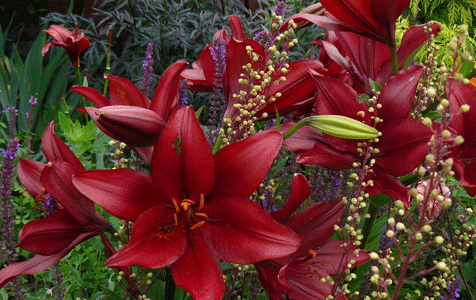
photo: Lily Red Arlet
Group 8A - Lilium LA-Hybrids
Planting term lilies: end of April - May or end of September - October
The term of flowering lilies: July
Lily height: 0.8-1.2 m
Lily flower size: 12-15 cm
Lily flower shape: classic star-shaped, wide-open
Lily planting distance: 20-30 cm
Planting depth of lily bulbs: 10-15 cm
Short description
Lilies LA hybrids (Lilium LA-Hybrids) - extraordinarily popular hybrids all over the world. Lilies LA hybrids are obtained by crossing Asiatic lilies and Longiflorum lilies (Longiflorum) and taking all the best from their parents: bright colors, winter hardiness and undemanding to growing conditions from Asian lilies and large, like waxy flowers from lilies longiflorum. The height of the lilies of the LA hybrids is from 80 to 120 cm. The flowers are large, with a diameter of up to 15 cm, and the widest color range: from pure white to bright burgundy. As a rule, almost odorless. The peak of flowering is in the middle of July. Lilies LA hybrids grow beautifully almost throughout the territory of Russia. Used as Asian lilies and to decorate the garden, and for cutting.
The most popular varieties of lilies are LA hybrids:
Lilia Eylainer / Lilium Eyeliner
Lilium Algarve / Lilium Algarve
Lilium Bright Diamond
Lilium Brindisi / Lilium Brindisi
Lilium Yellow Cocotte
Lily Indian Diamond
Lilium Cavalese
Lily Courier / Lilium Courier
Lilia Menorca / Lilium Menorca
Lilium Orange Cocotte / Lilium Orange Cocotte
Lilia Purple Diamond
Lilia Party Diamond / Lilium Party Diamond
Lilium Red Arlet / Lilium Red Arlet
Lilium Royal Sunset / Lilium Royal Sunset
Lilium Suncrest
Lilia Stainless Steel
Lilium Tailor Made
Lilium Tropic Diamond
Lilium Fangio
Lily Freya / Lilium Freya
Lilium Champagne Diamond
Lilia Ercolano / Lilium Ercolano
Growing lilies LA hybrids: see general
Buy lilies LA hybrids by mail You can from May to August and from October to March in our online store "Garden of Dreams" (see the relevant section)
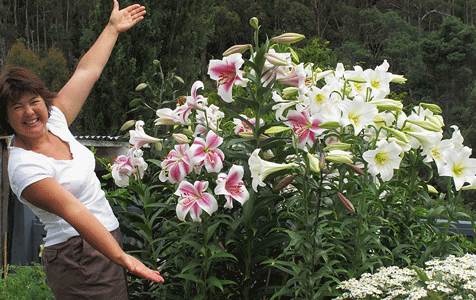
on the photo: Lily Garden Pleasure and Pretty Vuman
Group 8B - Lilia OT-hybrids (Lilium OT-Hybrids)
Planting term lilies: end of April - May or end of September - October
The term of flowering lilies: July August
Lily height: 1.2-2.5 m
Lily flower size: 20-30 cm
Lily flower shape: wide-eyed or funnel-shaped
Lily planting distance: 20-30 cm
Planting depth of lily bulbs: 15-20 cm
Short description
Lilia OT Hybrids (Lilium OT-Hybrids) - hybrids obtained by the crossing of oriental lilies (Oriental) and tubular lilies (Trumpet). Lilies OT hybrids are a huge number of beautiful flowers (up to 30 inflorescences) with a strong aroma. Flowers - very large, 20-25, and sometimes up to 30 cm, wide-shaped or funnel-shaped, directed upwards or to the side. The color of the flowers is yellow, pink, orange, red or multicolored. Lilies OT hybrids have strong, strong stems, the height of an adult, and even much higher, for which they are also called "Lilies-trees." The height of such lilies is often 120-180 cm, and under favorable conditions for 3 years, "Lilies-trees" can grow up to 2.5 m! The aroma is intermediate, closer to the Tubular Lilies, but more gentle and pleasant. The varieties of lithium ot-hybrids give an excellent cut and tolerate transportation. Also, lilies OT hybrids are suitable for decorating a garden, incl. grow well among fruit trees.
The most popular varieties of lilies OT-hybrids:
Lily Altari / Lilium Altari
Lily Anastasia / Lilium Anastacia
Lilium boogie woogie / Lilium Boogie Woogie
Lilia Visaversa / Lilium Visaversa
Lily Garden Pleasure / Lilium Garden Pleasure
Lilium Garden Affair
Lilium Kiss of Fire / Lilium Kiss of Fire
Lilia Lavon / Lilium Lavon
Lilia Life Style / Lilium Life Style
Lily Miss Lily / Lilium Miss Lily
Lily Miss Fairy / Lilium Miss Feya
Lilia Mr.Job / Lilium Job job
Lilia Orania / Lilium Orania
Lily Parple Prince / Lilium Purple Prince
Lilia Pretty Vuman / Lilium Pretty Woman
Lily Red Hot / Lilium Red Hot
Lilia Robert Swanson / Lilium Robert Swanson
Lilia Rossellini / Lilium Rosselini
Lilium Satisfaction
Lilia Friso / Lilium Friso
Lilia Hanimun / Lilium Honeymoon
Lily Scheherazade / Lilium Sheherazade
Growing lilies FROM hybrids: see general
Buy lilies OT hybrids by mail You can from May to August and from October to March in our online store "Garden of Dreams" (see the relevant section)
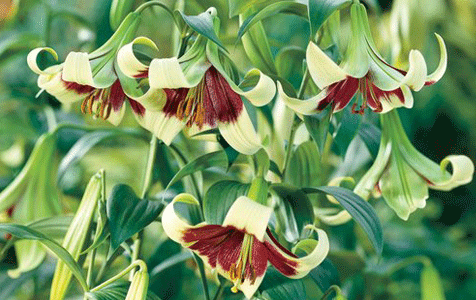
on the photo: Lily of Nepal
Group 9 - Species lilies (Lilium species)
Planting term lilies: end of April - May or end of September - October
The term of flowering lilies: June August
Lily height: 0.5-1.2 m
Lily flower size: 5-10 cm
Lily flower shape: varied
Lily planting distance: 20-30 cm
Planting depth of lily bulbs: 10-20 cm
Short description
Species lilies (Lilium species) - the group that entered wild species lilies, distributed mainly in southern Europe, East Asia, in the mountainous regions of India and also some species of lilies of North America. It contains about 100 lilies.
The most popular species of species of lilies: absent
Growing species of lilies: see general
Buy lilies species mail You can from May to August and from October to March in our online store "Garden of Dreams" (see the relevant section)
We begin the publication of chapters from the book "Lilies" by Ippolit Leopoldovich Zalivsky. This is a wonderful book that has never ceased to be relevant. Moreover, it is very fascinating, written in good clear language. Thanks to her, lilies will become closer and more understandable. And this is very important, because many people are frightened by the modern classification, which only a specialist can understand. Book Zalivskogo - for all.
Lilies belong to monocots and belong to the family of lilies, which includes tulips, grouse, bows, asparagus, lilies of the valley. In the dormitory, amaryllis, clivia, and krinums, belonging to the family of amaryllies, are often incorrectly called lilies, most of which are tropical plants that are widespread in room culture.
The rhizomatous plant of the lily family, the belladonna, or the daylily (Hemerocallis), also known in the ground culture, is also incorrectly called lilies. Water lilies are called water droplets (Nuphar) and water lilies (Nymphaea) from the buttercup family.
Lily bulbs have an imbricated, more or less friable structure and consist of scales devoid of outer films characteristic of tulip bulbs, onions, daffodils, and other bulbous plants; only coral lily bulbs are quite dense and sometimes covered with a yellowish-brown shell.
Fig. 1. Types of lily bulbs. 1 - with a wintering rosette of leaves 2 - stem-rhombus, 3 - rhizomatous, 4 - stolononosnaya, 5 - subglacial with a wandering stalk (orig.)
The number of scales and the density of their fit to each other, as well as their shape and nature of the articulation vary in different types of lilies. The scales of lily bulbs are white, yellow, pinkish brown, purple-brown and pink. After dredging and after drying, the color of lily bulbs often darkens, and the white color changes to pink and yellowish.The size of the bulbs of different types of lilies in normally developed flowering specimens range from 1-1.5 to 20-30 cm in diameter; in lilies Henry and Kesselring bulbs reach 2 kg of weight. Bulbs of many species can tolerate, without losing vitality, quite strong freezing; for example, bulbs of Dahurian lily, tiger and saffron - up to minus 30 ° C, Tibetan lily - up to minus 15 ° C, provided the bulbs are in the ground and more or less gradual freezing and thawing of the soil.
In our practice, the scales and fallen axillary bulbs (bulbs) of the most hardy lilies, namely tiger, daurus and bulbonous, were repeatedly transferred to the soil surface without snow cover, without losing viability, frosts down to minus 35 ° С.
The lily bulb has a stem-stem part, which is a convex, in many species, conical or cylindrical formation, from which scales and roots depart and which carries a growth point located in the center. In adult bulbs at the bottom, additional growth points are formed, from which new bulbs are formed, called subsidiaries, and the phenomenon itself is called bulb division. At first, in many species, daughter bulbs do not lose touch with the parent bulb, since they have a common base with it and are enclosed in common external scales. Gradually, the daughter bulbs go to their own roots and form a nest or colony.
Many species, in any case, all the stem-plants, on the lower part of the stem, above the stem roots form the so-called children, onions, growing in the axils of fallen off scales. Commonly onion-kids are formed in the upper layers of the soil or on its surface. In this way, nests or colonies of onion-bunks are formed on the soil surface.
In addition, many types of lilies on the stem, over its entire surface or only in its upper part, once or twice in summer form stem stem bulbs called leaf bulbs in the leaf axils; the bulbs of "ripening" fall away, in some species they are able to germinate while still on the stem.
From each individual bulb comes out only one stem, rosette or one leaf. The appearance of two or several stems from the ground in the place where one bulb was planted suggests that this bulb divided or managed to give the children the base of the stem, capable of sprouting and sometimes blooming in the first year of its formation. Usually, after the ejection of the stem, the bulb does not perish.
Lily roots in species with large bulbs reach 3 mm in diameter and up to 40-50 cm in length; in species with small bulbs - thinner and shorter; they are perennial and annual.
In some species, such as the white lily (Fig. 1, item 1), the roots develop only from the base of the bulb ends and are fully or partially perennial, why they should not be broken and overdried during transplants and transports.
In other species, for example, in tiger lily, Tibetan, Dahurian lilies (Fig. 1, item 2), additional roots are formed, extending from the base of the stem above the bulb, these are the so-called stem lilies; these roots die off every year.
According to the structure of the underground parts of the lily are divided into three groups:
1. Species with an onion, giving only an above-ground stalk.
2. Species with underground shoots - stolons, called stolononosnyh lilies. Such stolons are a modified bulb, the bottom of which is stretched into a sprout with rare scales, ending in a bud capable of producing an aboveground plant. Stolons can branch and give in this way several above-ground stalks. In some species, the stolons are shortened, densely scaled with scales and constitute an elongated bulb with an oblong base; The bulbs of such lilies are called rhizomatous. Under culture, stoloniferous lilies often form the normal structure of the bulb. All stolononosnye lilies, for example, the proud lily, reproduce well with scales (Fig. 1, p.3,4).
3. Species in which the stem, coming out of the bulb, grows obliquely underground and often reach the soil surface 20-30 cm away from the planted bulb, while onion grows on the underground part of the stem, as well as stem roots, usually in a small amount. Such lilies (Fig. 1, p. 5) are called lobster-colonizing, and their stems are wandering; the bulbs in them, for example, in the lily of Wilmotte, are not very suitable for pot and tub culture.
In most cases, the stems of lilies are round, only in some species they are tetrahedral. When hybridization is often obtained form with flat and ribbed stems (fasciation).
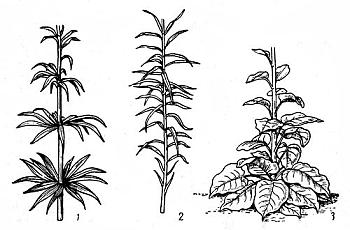 Fig. 2. The nature of the location of the leaves on the stem. 1 - whorled, 2 - alternate, 3 - alternate with basal rosette
Fig. 2. The nature of the location of the leaves on the stem. 1 - whorled, 2 - alternate, 3 - alternate with basal rosette
Golden lily has flowers up to 25 cm in diameter, flowers of sulfur lily reach 22 cm in length; under the weight of such flowers, the stems bend and often break, therefore, despite the considerable strength of the stems, many-flowered and large-flowered species of lilies need artificial support and a garter, even when grown in places protected from wind.
And such a lily as Tibetan, giving up to 30 heavy and large flowers in the inflorescence on a 2-meter stalk, despite the special strength of its thin stems, cannot maintain its inflorescences without support.
The height of the stems of lilies varies from 5 cm in the mountain-alpine form of Dahurian lily to 4 m in giant lily.
The leaves of lilies are usually more or less elongated, elliptical or lanceolate, less ovate and heart-shaped. The length of the leaves in different species varies from 1 to 15 cm, width - from 2 mm to 8 cm. The leaves are bare or pubescent, glossy or dull, always with more or less clearly expressed parallel venation.
In many species, for example, in the lily martagon, the leaves form up to 5–9 verticils arranged in tiers (Fig. 2, item 1); in some species, for example, in the oat lily, a whorl is one, it is slightly higher than the middle of the stem, and above it there are only single small leaves. In most species, the location of the leaves on the stem is regular (Fig. 2, item 2). Some lilies, in addition to the stem, form basal leaves, collected in the outlet (Fig. 2, item 3).
Lily flowers consist of 6 large and brightly colored separate perianth segments, 6 stamens with large brightly colored anthers and a pistil with the upper ovary. The pestle is formed by 6 carpels; the ovary has ovules located on the central placenta, the column is long, with a three-lobed, usually green, less often dark brown stigma. The fruit is a six-sided box, pawing after ripening from above, filled with flat semitransparent, somewhat winged seeds, tightly lying. The size and shape of the box vary from cylindrical to short pear-shaped and club-shaped.
The shape of the flowers of lilies is quite diverse in different species (Fig. 3). There are cup-shaped or cup-shaped flowers directed upwards (for example, in saffron and Dahurian lilies); flowers of the classical type - funnel-shaped, usually semi-thin (for example, in Tibetan and white lilies); talm-shaped flowers with back-shaped perianth segments turned back (by the end of flowering, they are often turned back to the pedicel), usually drooping (for example, in lily martagon and Wilmotte); bell-shaped flowers with curved tips of the perianth segments (for example, Kesselring lily).
At present, many hybrid forms of lilies between species with drooping chalmoid flowers, on the one hand, and species with open cup-shaped flowers, on the other, have been obtained by hybridization and selection. In these hybrids, such as Michalin's violet lily, the flowers are directed to the side with a bell. By selection, when sowing, varieties of lilies were obtained with flowers, directed obliquely upward, instead of drooping, inherent in wild forms.
In many species of lilies, terry forms have long been known in culture, and the phenomenon of the terry of a lily flower, as usual, is due to the partial or complete transformation of the stamens and pistil into petal-like perianth segments. Of these forms of lilies, the most common are: 1) the terry form of a tiger lily, perhaps the most beautiful and noteworthy; 2) terry, but rather ugly forms in umbrella lilies and Thunberg.
In our practice, Wilmotte and Dahurian lilies often produced beautiful double flowers, as well as 8-, 10-, and 12-petal forms, which were not maintained either during seed or during vegetative propagation.
 Fig. 3. Types of lily flowers. 1 - funnel-shaped, 2 - wide-open, 3 - cup-shaped, 4 - helm-shaped, 5 - tubular, 6 - bell-shaped
Fig. 3. Types of lily flowers. 1 - funnel-shaped, 2 - wide-open, 3 - cup-shaped, 4 - helm-shaped, 5 - tubular, 6 - bell-shaped
Finally, in culture, the terry form of the white lily is known, which represents the rebirth of all the organs of a flower into green segments of the perianth, having a spherical green "ovary" in the middle. This form is completely constant during vegetative reproduction, and the plant itself is distinguished by its endurance, but has no decorative value and does not produce seeds.
Flowers of lilies are usually collected in inflorescences; single flowers are observed only in weak or first-flowering plants.
Lily inflorescences are simple or complex of different lengths of brush or umbrellas, often collected in several tiers. Crusiform inflorescences usually have a pyramidal shape and are observed in species with zoronkovidnymi and chalmobraznye flowers. Umbrella and mutovchatye inflorescences characteristic of species with cup-shaped flowers, usually have a chandelier shape.
Currently about 85 are known. (Some floriculture manuals indicate that about 400 species of lilies are known. This is explained by the fact that the same types of lilies were described several times by different researchers under different names, resulting in the number of names known in the literature up to 400, due to repeated names (synonyms)) of lily species distributed in the northern hemisphere, namely: in Europe, Asia Minor and the Caucasus 13 species, in East and Central Asia 52, in North America 20. Of these, in the USSR 18 ide: 1 in the European part, the Caucasus 9, in Siberia and in the Far East 8 garden forms of hybrid origin are about 250. Almost all species introduced into the culture.
The lilies most valuable for ornamental gardening (golden, special, Tibetan, Sargent, Billmott, Dahurian, coral, drooping, etc.) come from East and Central Asia.
Of the European and Middle Eastern lilies, white lily and especially Caucasian lilies — Kesselring, single-sided, Shovitz, Pontic, Ledebour, Georgian, Armenian — should be noted. These lilies in culture have been studied relatively little, but are valuable for floriculture, especially as starting material for hybridization. Thus, these types of lilies are of great value and deserve wide distribution in ornamental gardening.
 Fig. 4. Terry flower of an umbrella lily (orig.)
Fig. 4. Terry flower of an umbrella lily (orig.)
Natural conditions for the growth of lilies are extremely diverse. Most species of lilies grow in mountainous areas of the Alpine and subalpine belts, on the slopes of hills and in the valleys of torrent rivers and streams, under the forest canopy, among shrubs, less often on open slopes, among dense grassy cover; Some species grow on bare slopes. Dying grass and fallen leaves of trees and shrubs form a good cover for wintering bulbs. In addition, a layer of loose snow, even with a capacity of up to 10 cm, protects the soil from strong freezing and sharp temperature fluctuations.
In the summertime, shrubs and grasses provide good wind protection and support for lily flower stalks. Thus, the soil near the base of the stems of lilies is usually considerably shaded. The upper part of the stems and inflorescences almost always enjoy full solar illumination, with the exception of a few species of lilies that bloom in some shading.
Lilies grow on different soils; Usually, the soil on which lilies grow, to a greater or lesser extent, consists of decomposed layers of dying grass grass and leaf humus, and in the valleys of rivers and streams - silty impurities. Some species grow on humus-poor soils. Many species prefer acidic soil, others require lime. Most lily species require well-drained soils; wherever lilies grow in natural conditions, their bulbs during dormancy are always located in permeable soil with a secure drain.
Lilies belong to monocots and belong to the family of lilies, which includes tulips, grouse, bows, asparagus, lilies of the valley. In the dormitory, amaryllis, clivia, and krinums, belonging to the family of amaryllies, are often incorrectly called lilies, most of which are tropical plants that are widespread in room culture.
The rhizomatous plant of the lily family, the belladonna, or the daylily (Hemerocallis), also known in the ground culture, is also incorrectly called lilies. Water lilies are called water droplets (Nuphar) and water lilies (Nymphaea) from the buttercup family.
Lily bulbs have an imbricated, more or less friable structure and consist of scales devoid of outer films characteristic of tulip bulbs, onions, daffodils, and other bulbous plants; only coral lily bulbs are quite dense and sometimes covered with a yellowish-brown shell. The number of scales and the density of their fit to each other, as well as their shape and nature of the articulation vary in different types of lilies. The scales of lily bulbs are white, yellow, pinkish brown, purple-brown and pink. After dredging and after drying, the color of lily bulbs often darkens, and the white color changes to pink and yellowish.
The size of the bulbs of different types of lilies in normally developed flowering specimens range from 1-1.5 to 20-30 cm in diameter; in lilies Henry and Kesselring bulbs reach 2 kg of weight.
Bulbs of many species can tolerate, without losing vitality, quite strong freezing; for example, bulbs of Dahurian lilies, tiger and saffron - up to minus 30 °, Tibetan lilies - up to minus 15 °, provided the bulbs are in the ground and more or less gradual freezing and thawing of the soil. In our practice, the scales and fallen axillary bulbs (bulbs) of the most hardy lilies, namely tiger, daurus and bulbonous, were repeatedly carried to the soil surface without snow cover, without losing viability, down to -35 ° C.
The lily bulb has a stem-stem part, which is a convex, in many species, conical or cylindrical formation, from which scales and roots depart and which carries a growth point located in the center. In adult bulbs at the bottom, additional growth points are formed, from which new bulbs are formed, called subsidiaries, and the phenomenon itself is called bulb division. At first, in many species, daughter bulbs do not lose touch with the parent bulb, since they have a common base with it and are enclosed in common external scales. Gradually, the daughter bulbs go to their own roots and form a nest or colony.
Many species, in any case, all the stem-plants, on the lower part of the stem, above the stem roots form the so-called children, onions, growing in the axils of fallen off scales. Commonly onion-kids are formed in the upper layers of the soil or on its surface.
In this way nests or colonies of onion-kids are formed on the soil surface.
In addition, many types of lilies on the stem, over its entire surface or only in its upper part, once or twice in summer form stem stem bulbs called leaf bulbs in the leaf axils; the bullets for “ripening” fall away, in some species they are able to germinate while still on the stem.
From each individual bulb comes out only one stem, rosette or one leaf. The appearance of two or several stems from the ground in the place where one bulb was planted suggests that this bulb divided or managed to give the children the base of the stem, capable of sprouting and sometimes blooming in the first year of its formation. Usually, after the ejection of the stem, the bulb does not perish.
Lily roots in species with large bulbs reach 3 mm in diameter and up to 40-50 cm in length; in species with small bulbs - thinner and shorter; they are perennial and annual.
In some species, such as the white lily (Fig. 1.1), the roots develop only from the base of the onion of the bulb and are fully or partially perennial, why during transplants and transportation they should not be broken and overdried.
In other species, such as tiger lily, Tibetan, Dahurian lilies (Fig. 1, 2), additional roots are formed, extending from the base of the stem above the bulb, these are the so-called stem lilies; these roots die off every year.
According to the structure of the underground parts of the lily are divided into three groups.
1. Species with an onion, giving only an above-ground stalk.
2. Species with underground shoots - stolons, called stolononosnyh lilies. Such stolons are a modified bulb, the bottom of which is stretched into a sprout with rare scales, ending in a bud capable of producing an aboveground plant. Stolons can branch and give in this way several above-ground stalks. In some species, the stolons are shortened, densely scaled with scales and constitute an elongated bulb with an oblong base; The bulbs of such lilies are called rhizomatous. Under culture, stoloniferous lilies often form the normal structure of the bulb. All stolononosnye lilies, such as the proud lily, reproduce well with scales (Fig. 1, 3 and 4).
3. Species in which the stem, coming out of the bulb, grows obliquely underground and often reach the soil surface 20-30 cm away from the planted bulb, while onion grows on the underground part of the stem, as well as stem roots, usually in a small amount. Such lilies (fig. 1, 5) are called loge colony-bearing, and their stems are wandering; the bulbs in them, for example, in the lily of Wilmotte, are not very suitable for pot and tub culture.
In most cases, the stems of lilies are round, only in some species they are tetrahedral. When hybridization is often obtained form with flat and ribbed stems (fasciation).
Stems of lilies crowned with one or more flowers; sometimes, for example, in a hybrid of lilies Maksimovich and Willmott, there are more than 100 of them. Golden lily has flowers up to 25 cm in diameter, flowers of sulfur lily reach 22 cm in length; under the weight of such flowers, the stems bend and often break, therefore, despite the considerable strength of the stems, many-flowered and large-flowered species of lilies need artificial support and a garter, even when grown in places protected from wind. And such a lily as Tibetan, giving up to 30 heavy and large flowers in the inflorescence on a 2-meter stalk, despite the special strength of its thin stems, is unable to retain its inflorescences without support.
The height of the stems of lilies varies from 5 cm in the mountain-alpine form of Dahurian lily to 4 m in giant lily.
The leaves of lilies are usually more or less elongated, elliptical or lanceolate, less ovate and heart-shaped. The length of the leaves in different species varies from 1 to 15 cm, width - from 2 mm to 8 cm. The leaves are bare or pubescent, glossy or dull, always with more or less clearly expressed parallel venation.
In many species, for example, in the lily martagon, the leaves form up to 5–9 verticils arranged in tiers (Fig. 2, 1); in some species, for example, in the oat lily, a whorl is one, it is slightly higher than the middle of the stem, and above it there are only single small leaves. In most species, the location of the leaves on the stem is alternate (Fig. 2, 2). Some lilies, in addition to the stem, form basal leaves, collected in the outlet (Fig. 2.3).

Lily flowers consist of 6 large and brightly colored separate perianth segments, 6 stamens with large brightly colored anthers and a pistil with the upper ovary. The pestle is formed by 6 carpels; the ovary has ovules located on the central placenta, the column is long, with a three-lobed, usually green, less often dark brown stigma. The fruit is a six-sided box, pawing after ripening from above, filled with flat semitransparent, somewhat winged seeds, tightly lying. The size and shape of the box vary from cylindrical to short pear-shaped and club-shaped.
The shape of the flowers of lilies is quite diverse in different species (Fig. 3). There are cup-shaped or cup-shaped flowers directed upwards (for example, in saffron and Dahurian lilies); flowers of the classical type - funnel-shaped, usually semi-thin (for example, in Tibetan and white lilies); talm-shaped flowers with back-shaped perianth segments turned back (by the end of flowering, they are often turned back to the pedicel), usually drooping (for example, in lily martagon and Wilmotte); bell-shaped flowers with curved tips of the perianth segments (for example, Kesselring lily).

At present, many hybrid forms of lilies between species with drooping chalmoid flowers, on the one hand, and species with open cup-shaped flowers, on the other, have been obtained by hybridization and selection. In these hybrids, such as Michalin's violet lily, the flowers are directed to the side with a bell. By selection, when sowing, varieties of lilies were obtained with flowers, directed obliquely upward, instead of drooping, inherent in wild forms.
In many species of lilies, terry forms have long been known in culture, and the phenomenon of the terry of a lily flower, as usual, is due to the partial or complete transformation of the stamens and pistil into petal-like perianth segments. Of these forms of lilies, the most common are: 1) the terry form of a tiger lily, perhaps the most beautiful and noteworthy; 2) terry, but rather ugly forms in umbrella lilies and Thunberg.
In our practice, Wilmotte and Dahurian lilies often produced beautiful double flowers, as well as 8-, 10- and 12-petal forms, which were not maintained during seed or vegetative propagation.
We are investigating an extremely peculiar form of the terry, obtained from a seedling of an umbrella lily with light-colored flowers. When self-dividing the bulbs of this seedling, a certain amount (about 1/3) of the specimens is obtained with an exceptionally original spherical flower, formed from several flowers fused together by the ovaries. The number of perianth segments of such “flowers” reaches 24, they are strongly elongated and converge arcuately, touching the upper ends at one point, forming a ball. These flowers bloom 10 days earlier than the normally developed flowers of our seedling (Fig. 4).
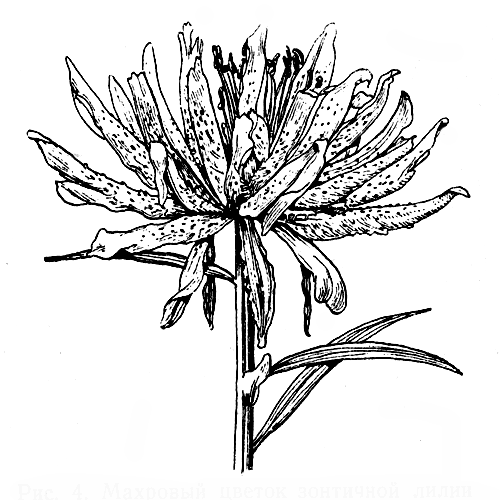
Finally, in culture, the terry form of a white lily is known, which represents the degeneration of all the flower organs into green segments of the perianth, having a spherical green "ovary" in the middle. This form is completely constant during vegetative reproduction, and the plant itself is distinguished by its endurance, but has no decorative value and does not produce seeds.
Flowers of lilies are usually collected in inflorescences; single flowers are observed only in weak or first-flowering plants.
Lily inflorescences are simple or complex of different lengths of brush or umbrellas, often collected in several tiers. Crusiform inflorescences usually have a pyramidal shape and are observed in species with zoronkovidnymi and chalmobraznye flowers. Umbrella and mutovchatye inflorescences characteristic of species with cup-shaped flowers, usually have a chandelier shape.
Currently, about 85 are known ( Some Floriculture manuals indicate that about 400 species of lilies are known. This is explained by the fact that the same types of lilies were described several times by different researchers under different names, with the result that the number of names known in the literature reaches 400, due to repeated names (synonyms)) species of lilies, common in the northern hemisphere, namely: in Europe, Asia Minor and the Caucasus 13 species, in East and Central Asia 52, in North America 20. Of these, 18 species are found in the USSR: in European part 1, in the Caucasus 9, in Siberia and the Far East. There are about 250 garden forms of hybrid origin. Almost all species have been introduced into culture.
The lilies most valuable for ornamental gardening (golden, special, Tibetan, Sargent, Billmott, Dahurian, coral, drooping, etc.) come from East and Central Asia.
Of the European and Middle Eastern lilies, white lily and especially Caucasian lilies — Kesselring, single-sided, Shovitz, Pontic, Ledebour, Georgian, Armenian — should be noted.
These lilies in culture have been studied relatively little, but are valuable for floriculture, especially as starting material for hybridization.
Thus, these types of lilies are of great value and deserve wide distribution in ornamental gardening.
Most lilies live in a cold and temperate climate, often in the high-mountain belt, exclusively in the northern hemisphere, therefore the culture of most species of lilies is quite possible in the vast territory of the USSR, including the middle and northern parts.
Natural conditions for the growth of lilies are extremely diverse. Most species of lilies grow in mountainous areas of the Alpine and subalpine belts, on the slopes of hills and in the valleys of torrent rivers and streams, under the forest canopy, among shrubs, less often on open slopes, among dense grassy cover; Some species grow on bare slopes. Dying grass and fallen leaves of trees and shrubs form a good cover for wintering bulbs. In addition, a layer of loose snow, even with a capacity of up to 10 cm, protects the soil from strong freezing and sharp temperature fluctuations.
In the summertime, shrubs and grasses provide good wind protection and support for lily flower stalks. Thus, the soil near the base of the stems of lilies is usually considerably shaded. The upper part of the stems and inflorescences almost always enjoy full solar illumination, with the exception of a few species of lilies that bloom in some shading. Lilies grow on different soils; Usually, the soil on which lilies grow, to a greater or lesser extent, consists of decomposed layers of dying grass grass and leaf humus, and in the valleys of rivers and streams - silty impurities. Some species grow on humus-poor soils. Many species prefer acidic soil, others require lime. Most lily species require well-drained soils; wherever lilies grow in natural conditions, their bulbs during dormancy are always located in permeable soil with a secure drain.


